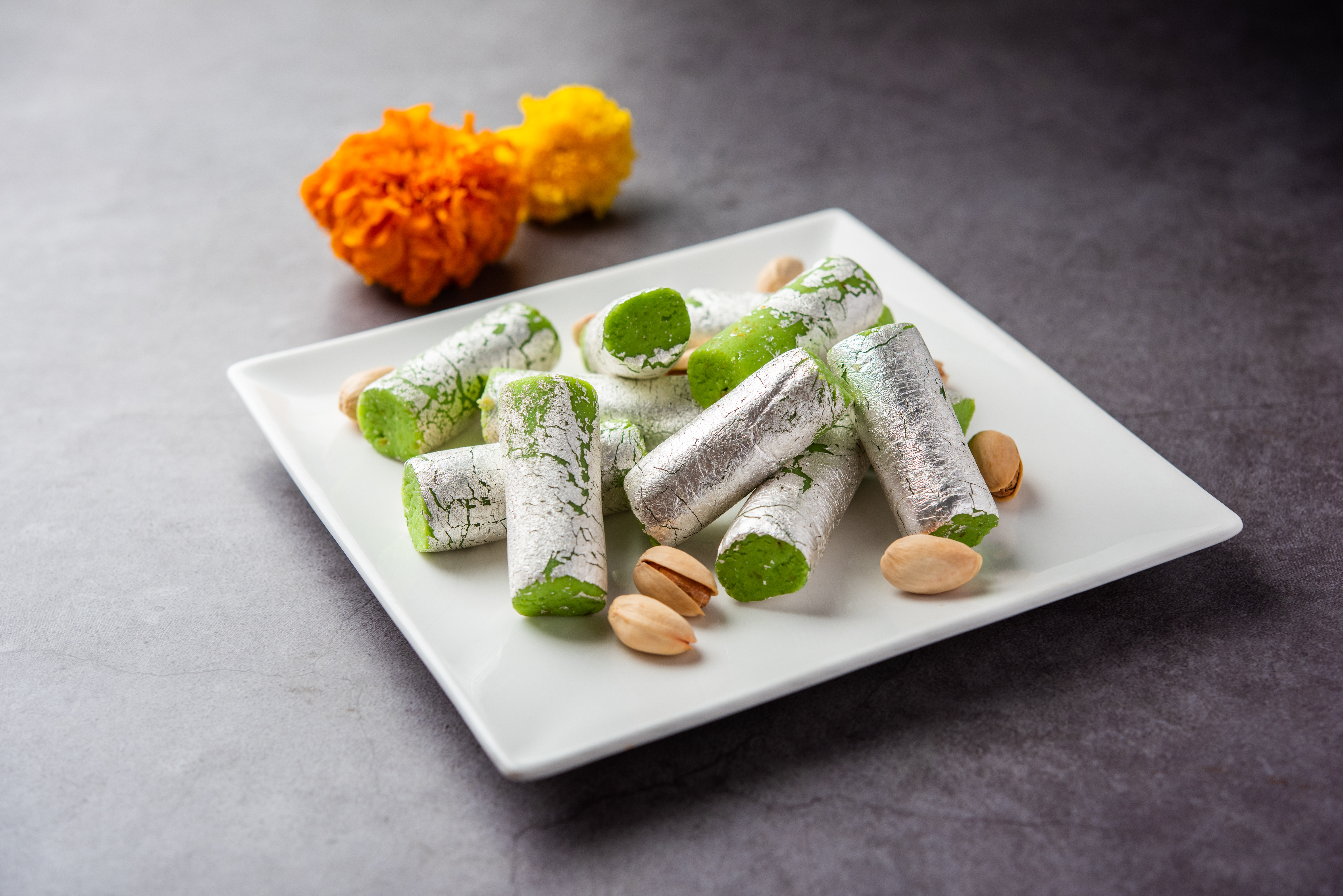
Diwali, the Festival of Lights, is a time of joy, togetherness, and celebration for millions of people across the globe. While traditionally marked with sweets, dairy-laden delicacies, and sumptuous feasts, an increasing number of individuals are choosing to embrace a different path to happiness during Diwali—veganism. This shift not only brings about a sense of compassion towards animals but also offers numerous health benefits, paving the way for a healthier, more sustainable, and fulfilling Diwali.
The Ethics of Veganism
Before delving into the health aspects of veganism during Diwali, it’s essential to understand the ethical foundation of this choice. Veganism is more than just a dietary preference; it’s a lifestyle built on the principles of non-violence (ahimsa) and compassion. Diwali, with its emphasis on light triumphing over darkness and good over evil, provides a perfect backdrop for embracing these principles.
By abstaining from animal products, vegans reject the inherent cruelty of factory farming and the suffering of sentient beings. This aligns beautifully with the spirit of Diwali, where people light lamps to dispel darkness and ignorance. The choice to go vegan embodies the essence of Diwali by spreading the light of compassion and kindness, not only to fellow humans but also to animals who share this planet.
The Health Benefits of a Vegan Diwali
Improved Heart Health: A vegan diet is naturally low in saturated fats and cholesterol, which are common contributors to heart disease. By choosing plant-based foods during Diwali, you can reduce your risk of heart-related issues, promoting overall well-being.
Weight Management: Many traditional Diwali dishes are calorie-dense and heavy, leading to weight gain. Vegan alternatives, based on whole plant foods, are often lower in calories and promote weight maintenance, ensuring that you don’t feel sluggish during the festivities.
Better Digestion: Rich, fatty foods can often lead to digestive discomfort. A vegan Diwali menu with fruits, vegetables, and whole grains can ease digestion and leave you feeling light and energetic.
Reduced Risk of Diabetes: A vegan diet can help lower the risk of type 2 diabetes by improving insulin sensitivity and glycaemic control. This is especially relevant during Diwali when sweets are in abundance.
Enhanced Immunity: Plant-based diets are rich in antioxidants and vitamins that bolster the immune system. Celebrating Diwali as a vegan can help you stay healthy and ward off common seasonal illnesses.
Mental Clarity: Consuming plant-based foods that are free from additives and preservatives can contribute to mental clarity and improved focus, enhancing your overall happiness during Diwali.
The Joy of Vegan Diwali Feasting
Transitioning to a vegan Diwali diet doesn’t mean sacrificing the rich and diverse flavours that this festival is known for. Instead, it opens up exciting new avenues for creative cooking and culinary exploration. Here are some vegan alternatives for traditional Diwali dishes:
Vegan Sweets: Replace dairy-based sweets with vegan options made from ingredients like coconut milk, almond milk, and cashew cream. Vegan barfis, laddoos, and halwas are delicious and cruelty-free.
Plant-Based Curries: Instead of meat or dairy-based curries, try flavourful dishes made from chickpeas, lentils, or tofu. Vegan butter chicken, dal makhani, and palak paneer are crowd-pleasers.
Vegan Biryani: Swap out meat for vegetables or tofu in your biryani for a fragrant and satisfying main dish.
Vegan Snacks: Prepare crispy pakoras, samosas, and chaats using plant-based ingredients. The flavours remain authentic while being animal-friendly.
Vegan Desserts: Experiment with vegan cakes, cookies, and ice creams made with alternatives like almond flour, coconut oil, and plant-based sweeteners.
Nut-Based Sweets: Cashews, almonds, and pistachios make excellent bases for vegan sweets like kaju katli and pista barfi.
The Environmental Impact
Embracing a vegan lifestyle during Diwali also has a positive impact on the environment. The traditional dairy and meat industries contribute significantly to greenhouse gas emissions, deforestation, and water pollution. By choosing vegan alternatives, you can reduce your carbon footprint and contribute to a more sustainable future, aligning with the ethos of Diwali, which celebrates the preservation of the earth and its resources.
Here are 15 easy to make recipes to add up to your Diwali celebrations
Coconut Barfi
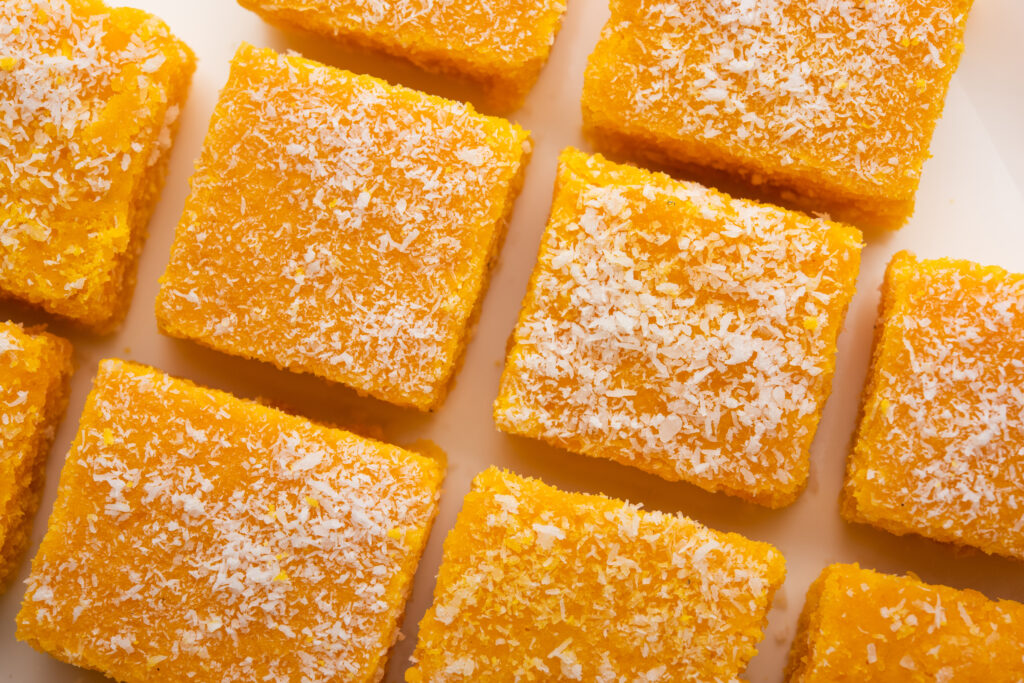
Ingredients:
2 cups of desiccated coconut
1 cup of condensed milk
1/2 cup of milk
1/4 cup of sugar (adjust to taste)
1/4 teaspoon of cardamom powder (optional)
A pinch of saffron strands (optional)
2 tablespoons of ghee (clarified butter)
Chopped nuts for garnish (optional)
Instructions:
- Heat a non-stick pan or a heavy-bottomed pan on medium-low heat and add the desiccated coconut. Dry roast it for a few minutes until it turns light golden brown and gives off a nice aroma. Stir continuously to prevent burning.
- In another pan, heat the ghee on low heat. Add the condensed milk and milk to it. Mix well and let it heat up.
- Once the milk mixture is warm, add the roasted desiccated coconut and sugar to it. Stir continuously on low heat.
- Keep stirring the mixture until it thickens and starts to leave the sides of the pan. This can take around 10-15 minutes.
- If using cardamom powder or saffron, add them to the mixture and stir well for another couple of minutes to incorporate the flavours.
- Remove the mixture from the heat and transfer it to a greased plate or tray. Flatten and smoothen the top using a spatula.
- Optionally, garnish the top with chopped nuts, pressing them gently into the mixture.
- Allow the coconut mixture to cool down for a few hours at room temperature until it firms up.
- Once it has set, cut it into square or diamond-shaped pieces.
- Your Coconut Barfi is ready to be enjoyed! Store the leftovers in an airtight container.
Coconut Barfi is a delightful and sweet treat that’s perfect for celebrating festivals like Diwali or for satisfying your sweet cravings anytime. Enjoy!
Besan-Dryfruit Laddoo
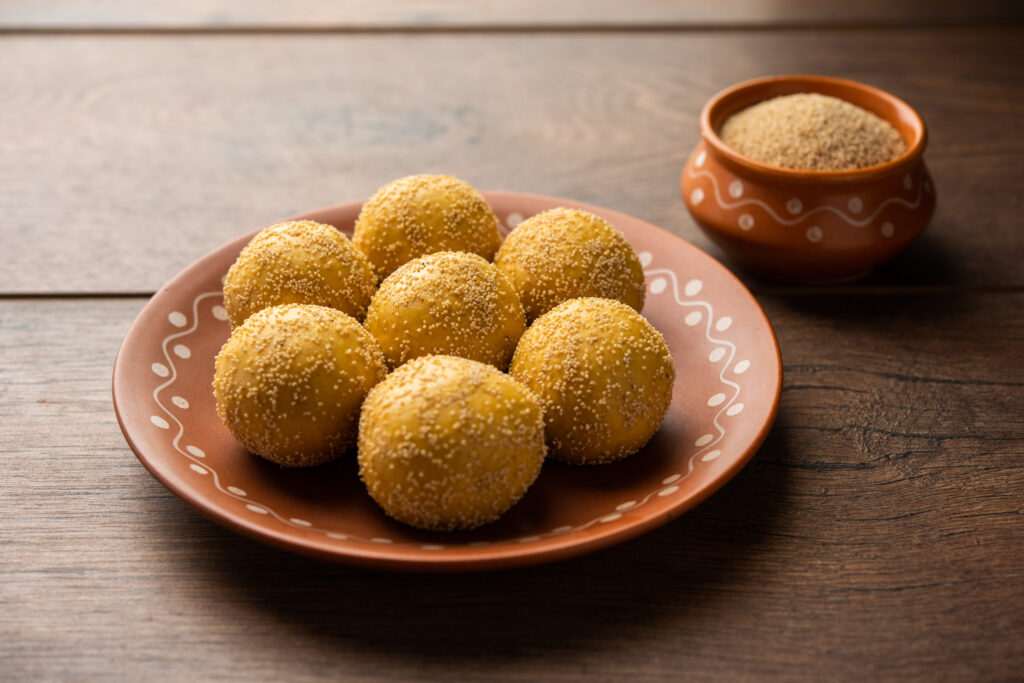
Ingredients:
1 cup besan (gram flour)
1/2 cup powdered sugar (adjust to taste)
1/4 cup ghee (clarified butter)
1/4 cup mixed dry fruits (chopped; almonds, cashews, pistachios, and raisins)
1/2 teaspoon cardamom powder
A pinch of saffron strands (optional)
Desiccated coconut for coating (optional)
Instructions:
- Heat a heavy-bottomed pan or kadai on low-medium heat and add the ghee to it. Let the ghee melt completely.
- Once the ghee is melted, add the besan (gram flour) to it.
- Roast the besan in the ghee on low-medium heat, stirring continuously to avoid lumps. Keep stirring until the besan turns golden brown and emits a nutty aroma. This can take around 15-20 minutes.
- While the besan is roasting, you can also heat a small quantity of milk and saffron strands together in a separate pan. Once the saffron releases its color, set it aside.
- Once the besan is roasted, reduce the heat to low and add the cardamom powder and saffron-infused milk (if using). Mix well.
- Add the powdered sugar to the roasted besan mixture and mix thoroughly. The heat from the besan will melt the sugar, and the mixture will become a bit loose initially.
- Continue to cook the mixture on low heat while stirring continuously. It will start thickening and coming together as you cook.
- After about 5-7 minutes, when the mixture has thickened and starts leaving the sides of the pan, turn off the heat.
- Allow the mixture to cool for a few minutes until it is safe to handle but still warm.
- While the mixture is still warm, add the chopped mixed dry fruits and mix well.
- Grease your hands with a little ghee and shape the warm mixture into small laddoos (round balls). Roll each laddoo in desiccated coconut if desired.
- Let the laddoos cool completely at room temperature. As they cool, they will firm up.
- Once cooled and firm, store the Besan-Dry fruit Laddoos in an airtight container.
Butterscotch –Almond rolls
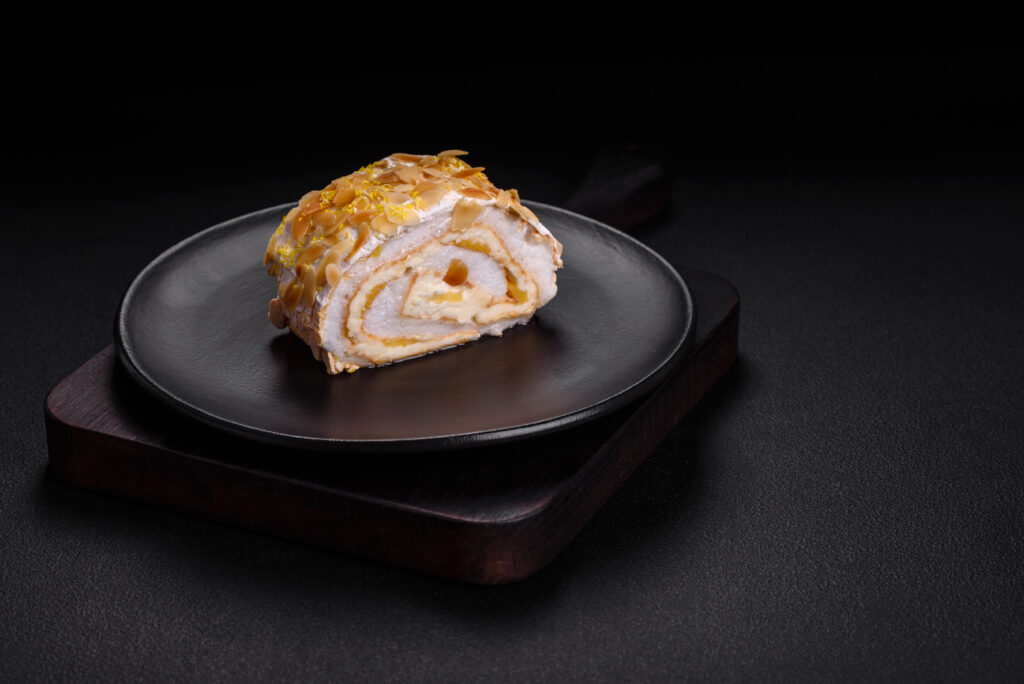
Ingredients:
For the Dough:
2 and 1/4 cups all-purpose flour
2 tablespoons granulated sugar
1 packet (2 and 1/4 teaspoons) active dry yeast
1/2 teaspoon salt
1 cup warm milk (about 110°F or 43°C)
2 tablespoons unsalted butter, melted
1 egg
For the Filling:
1/2 cup unsalted butter, softened
1 cup brown sugar
1/2 cup chopped almonds
1/2 cup butterscotch chips
1 teaspoon ground cinnamon (optional)
For the Glaze:
1 cup powdered sugar
2-3 tablespoons milk
1/2 teaspoon vanilla extract
Instructions:
- In a large mixing bowl, combine the warm milk, granulated sugar, and yeast. Let it sit for about 5-10 minutes until it becomes frothy.
- Add the melted butter and egg to the yeast mixture, and stir to combine.
- In a separate bowl, whisk together the flour and salt. Gradually add the dry ingredients to the wet mixture, stirring until a soft dough forms.
- Knead the dough on a lightly floured surface for about 5 minutes until it becomes smooth and elastic. Form it into a ball.
- Place the dough in a greased bowl, cover it with a clean kitchen towel or plastic wrap, and let it rise in a warm, draft-free place for about 1-2 hours, or until it has doubled in size.
- Once the dough has risen, punch it down to release any air bubbles.
- Roll out the dough on a floured surface into a rectangle, approximately 12×18 inches in size.
- Spread the softened butter evenly over the surface of the dough.
- In a small bowl, combine the brown sugar, chopped almonds, butterscotch chips, and ground cinnamon (if using). Sprinkle this mixture evenly over the buttered dough.
- Starting from one of the long sides, tightly roll the dough into a log.
- Using a sharp knife, cut the rolled dough into 12 equal-sized rolls.
- Place the rolls in a greased baking dish, leaving a little space between each one. Cover the dish with a kitchen towel and let the rolls rise for another 30 minutes.
- Preheat your oven to 350°F (175°C) while the rolls are rising.
- Bake the rolls in the preheated oven for 20-25 minutes or until they are golden brown on top and cooked through.
- While the rolls are baking, prepare the glaze. In a small bowl, mix together the powdered sugar, milk, and vanilla extract until smooth.
- Once the rolls are done, remove them from the oven and let them cool for a few minutes.
- Drizzle the glaze over the warm Butterscotch Almond Rolls.
- Serve the rolls warm and enjoy!
Kaju Pista Rolls
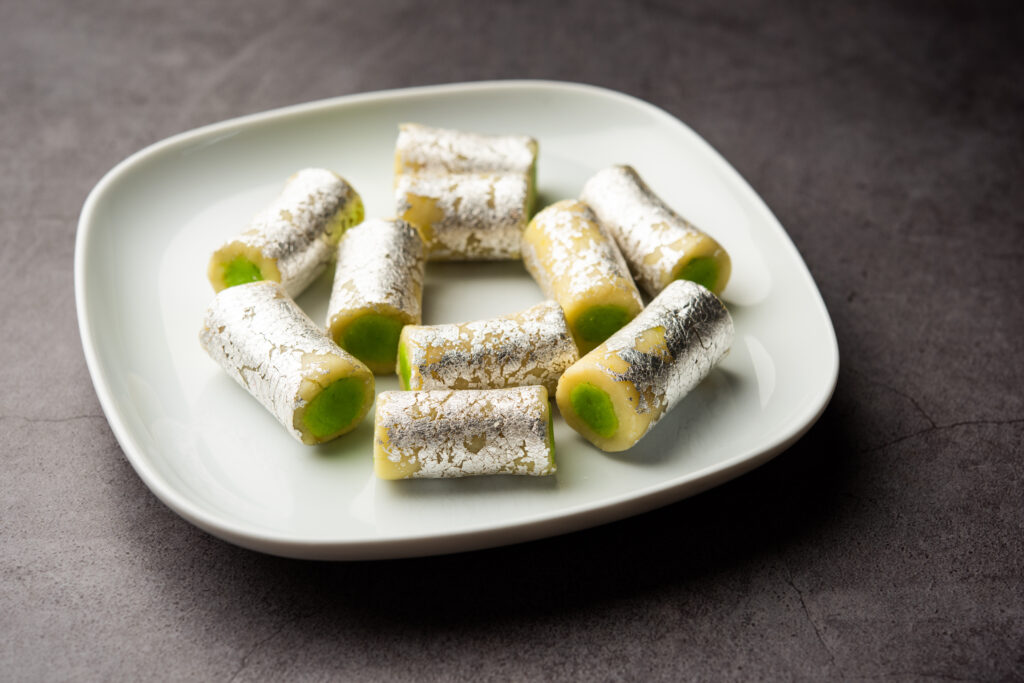
Ingredients:
1 cup cashews (kaju)
1/4 cup pistachios (pista)
1 cup sugar
1/2 cup water
1/4 teaspoon cardamom powder
A few drops of green food colouring (optional)
Ghee or clarified butter for greasing
Instructions:
- Start by grinding the cashews and pistachios separately into a fine powder. Make sure they are dry and not moist to achieve a smooth texture.
- In a mixing bowl, combine the cashew powder and a few drops of green food colouring (if using). Mix well until the color is evenly distributed. This step is optional and can be skipped if you prefer the natural color.
- Take the sugar and water in a pan and cook over medium heat to make a sugar syrup. Stir continuously until the syrup reaches a one-string consistency. To test, take a drop of syrup between your thumb and index finger; it should form a single string when stretched apart.
- Once the syrup reaches the desired consistency, add cardamom powder and mix it in.
- Now, add the cashew powder mixture to the sugar syrup. Reduce the heat to low and continue stirring. Cook the mixture until it thickens and starts leaving the sides of the pan. This can take around 5-7 minutes.
- Turn off the heat and let the mixture cool slightly. Make sure it’s cool enough to handle but still warm.
- Grease your hands and a clean, dry surface with ghee. Place the cashew-pistachio mixture on the greased surface and knead it into a smooth, non-sticky dough.
- Roll out the dough into a thin rectangular sheet using a rolling pin. You can place a butter paper over the dough to prevent sticking.
- Sprinkle the finely chopped pistachios over the rolled sheet and gently press them into the dough.
- Now, carefully roll the sheet into a log, making sure it’s tightly rolled. Seal the edges.
- Let the rolled log sit for a few hours to set. You can refrigerate it to speed up the process.
- Once set, slice the log into small pieces, about 1-inch in width, to make the rolls.
- Your Kaju Pista Rolls are ready to be served. Enjoy this delicious Indian sweet!
Saffron Shankarpali
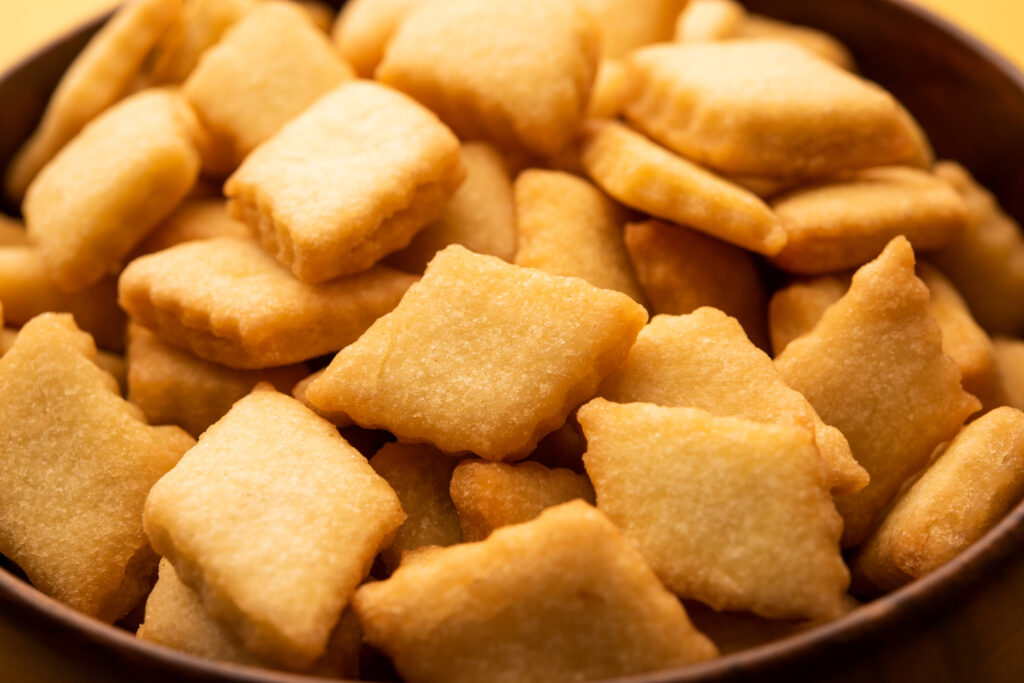
Ingredients:
2 cups all-purpose flour (Maida)
1/2 cup fine semolina (rava or sooji)
1/2 cup powdered sugar
A pinch of saffron strands (soaked in 2 tablespoons warm milk)
1/4 cup ghee (clarified butter)
A pinch of salt
Oil for deep frying
Instructions:
- In a mixing bowl, combine the all-purpose flour, fine semolina, powdered sugar, and a pinch of salt.
- In a small bowl, soak a pinch of saffron strands in 2 tablespoons of warm milk. Allow it to sit for a few minutes until the milk takes on the saffron’s color and flavour.
- In another small pan, melt 1/4 cup of ghee over low heat. Be careful not to overheat it.
- Once the ghee is melted, add the saffron-infused milk to it and mix well.
- Now, pour the saffron-infused ghee mixture into the dry ingredients in the mixing bowl.
- Mix everything together to form a crumbly mixture.
- Gradually, add a little water (1-2 tablespoons at a time) and knead the mixture into a smooth and firm dough. Be careful not to over-knead it.
- Divide the dough into small portions and roll each portion into a smooth ball.
- Roll out each ball into a thin disc, about 1/8 inch thick.
- Use a knife or a cookie cutter to cut the rolled dough into diamond or square shapes. You can also make decorative patterns with a fork on each piece if you like.
- Heat oil in a deep frying pan over medium heat. To check if the oil is ready for frying, drop a small piece of dough into the oil. If it sizzles and rises to the surface, the oil is hot enough.
- Carefully slide a few pieces of the cut dough into the hot oil. Fry them until they turn golden brown and crispy. Ensure even frying by stirring occasionally.
- Remove the fried shankarpali using a slotted spoon and drain excess oil by placing them on a paper towel-lined plate.
- Repeat the frying process with the remaining dough pieces.
- Once the saffron shankarpali cools down completely, store them in an airtight container. They will remain fresh for several days.
Vegan Malai Kofta
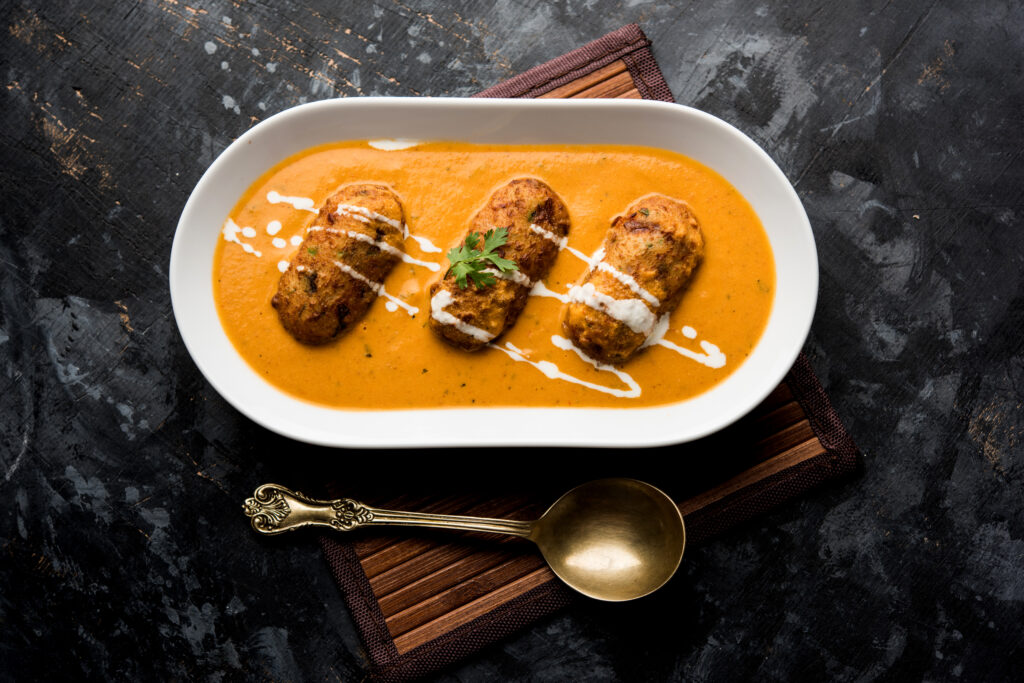
Ingredients:
For the Vegan Kofta:
2 cups cauliflower florets
2 medium-sized potatoes, boiled and mashed
1/2 cup firm tofu, crumbled
2 tablespoons corn-starch or chickpea flour (besan)
Salt to taste
1/2 teaspoon garam masala
1/2 teaspoon red chili powder
Oil for frying
For the Vegan Malai (Cream) Sauce:
1 cup cashews, soaked in hot water for 30 minutes
2 tablespoons coconut oil or any neutral cooking oil
1 large onion, finely chopped
2 cloves garlic, minced
1-inch piece of ginger, minced
1 can (14 oz) crushed tomatoes or 3-4 ripe tomatoes, pureed
1/2 teaspoon turmeric powder
1 teaspoon ground coriander
1 teaspoon cumin powder
1 teaspoon paprika or red chili powder
1 teaspoon garam masala
1 cup coconut milk or any plant-based milk
Salt to taste
Fresh cilantro leaves for garnish
Instructions:
For the Vegan Kofta:
- Steam or boil the cauliflower florets until they are tender. Drain any excess water and let them cool.
- Once cooled, finely chop the cauliflower or pulse it in a food processor until it resembles breadcrumbs.
- In a large mixing bowl, combine the chopped cauliflower, mashed potatoes, crumbled tofu, corn-starch (or chickpea flour), salt, garam masala, and red chili powder. Mix everything together to form a smooth dough-like mixture.
- Divide the mixture into small portions and shape them into round or oval kofta dumplings.
- Heat oil in a deep frying pan over medium-high heat. Carefully fry the kofta dumplings until they are golden brown and crispy. Remove them using a slotted spoon and place them on a paper towel to remove excess oil. Set aside.
For the Vegan Malai (Cream) Sauce:
- Drain the soaked cashews and blend them into a smooth paste with a little water. Set aside.
- In a large skillet, heat coconut oil over medium heat. Add the chopped onion and sauté until it becomes translucent.
- Stir in the minced garlic and ginger, and cook for another minute until fragrant.
- Add the tomato puree, turmeric powder, ground coriander, cumin powder, paprika (or red chili powder), garam masala, and salt. Cook the mixture, stirring occasionally, until the oil starts to separate from the sauce, which may take about 10-15 minutes.
- Add the cashew paste and coconut milk (or plant-based milk) to the tomato mixture. Mix well and let it simmer for a few minutes until the sauce thickens.
- Gently place the fried vegan kofta dumplings into the sauce and let them simmer for a couple of minutes to absorb the flavours.
- Garnish with fresh cilantro leaves.
Jaggery- Chana Kheer
Ingredients:
1/2 cup dried chickpeas (Chana)
1 cup jaggery (Gur), grated or chopped
4 cups milk
1/2 teaspoon cardamom powder
A pinch of saffron strands (optional)
2 tablespoons chopped nuts (almonds, cashews, pistachios)
Ghee (clarified butter) for frying nuts (optional)
A few strands of saffron for garnish (optional)
Instructions:
- Rinse the dried chickpeas (Chana) thoroughly and soak them in enough water for at least 6 hours or overnight. Drain and rinse them again.
- In a large pot, add the soaked chickpeas and enough water to cover them. Bring to a boil, reduce the heat to a simmer, and cook until the chickpeas are tender. This can take about 45 minutes to 1 hour. Drain the cooked chickpeas and set them aside.
- In a separate pan, heat a small amount of ghee (clarified butter) and lightly fry the chopped nuts until they turn golden brown. Set aside for garnishing.
- In the same pan, add the grated or chopped jaggery along with a little water. Heat it over medium-low heat, stirring continuously until the jaggery completely dissolves and forms a syrup. Remove from heat and strain the syrup to remove any impurities.
- In a large, heavy-bottomed pot, add the milk and bring it to a boil. Reduce the heat and let it simmer, stirring occasionally, until it reduces to about half its original volume. This can take around 30-40 minutes.
- Add the cooked chickpeas to the simmering milk and continue to cook for another 10-15 minutes, stirring occasionally.
- Now, add the jaggery syrup to the pot and mix well with the chickpeas and milk.
- Add cardamom powder and saffron strands (if using), and let the kheer simmer for an additional 5-10 minutes, allowing all the flavours to meld.
- Turn off the heat and let the jaggery Chana kheer cool down to room temperature.
- Garnish the kheer with the fried nuts and saffron strands (if using).
- Serve the jaggery Chana kheer chilled or at room temperature as a delightful Indian dessert.
Spicy cocktail peanuts
Ingredients:
2 cups raw peanuts
1 tablespoon oil (vegetable or peanut oil)
1 teaspoon chili powder (adjust to taste)
1/2 teaspoon paprika
1/2 teaspoon cayenne pepper (adjust to taste)
1/2 teaspoon garlic powder
1/2 teaspoon onion powder
1/2 teaspoon salt (adjust to taste)
1/4 teaspoon black pepper
1/4 teaspoon cumin powder
1/4 teaspoon coriander powder
1/4 teaspoon turmeric powder (optional for color)
1 tablespoon water
Instructions:
- Preheat your oven to 350°F (175°C) and line a baking sheet with parchment paper or a silicone baking mat.
- In a mixing bowl, combine the raw peanuts and all the dry spices (chili powder, paprika, cayenne pepper, garlic powder, onion powder, salt, black pepper, cumin powder, coriander powder, and turmeric powder).
- Add 1 tablespoon of water to the spice-coated peanuts and mix well to create a slightly damp coating.
- Spread the seasoned peanuts evenly on the prepared baking sheet.
- Drizzle 1 tablespoon of oil evenly over the peanuts.
- Bake the peanuts in the preheated oven for about 20-25 minutes, stirring every 5-7 minutes to ensure even coating and prevent burning.
- The peanuts are ready when they turn a shade darker and become crispy. Keep a close eye on them as cooking times may vary.
- Once done, remove the spicy cocktail peanuts from the oven and let them cool completely on the baking sheet.
- Once they have cooled, transfer the peanuts to an airtight container for storage.
Figs and Dry fruit Barfi
Ingredients:
1 cup dried figs (anjeer)
1/2 cup mixed dry fruits (almonds, cashews, pistachios), finely chopped
1/2 cup sweetened condensed milk
2 tablespoons ghee (clarified butter)
1/2 teaspoon cardamom powder
A pinch of saffron strands (optional)
Silver leaf (varak) for garnish (optional)
Instructions:
- Start by soaking the dried figs in warm water for about 15-20 minutes to soften them. After soaking, drain the water and pat the figs dry.
- In a food processor or blender, pulse the dried figs until they turn into a coarse paste. You may need to scrape down the sides of the bowl a few times to ensure even blending.
- In a large non-stick pan or kadai, heat the ghee over medium-low heat.
- Add the chopped mixed dry fruits to the pan and roast them in the ghee for a couple of minutes until they become aromatic and slightly golden. Remove some of the roasted dry fruits for garnish, if desired.
- Add the fig paste to the pan and continue to cook, stirring continuously, for about 5-7 minutes. The fig paste will start to thicken and leave the sides of the pan.
- Add the sweetened condensed milk and continue to cook, stirring continuously, until the mixture thickens and starts to leave the sides of the pan. This can take another 7-10 minutes.
- Stir in the cardamom powder and saffron strands (if using), and mix well.
- Remove the pan from the heat and transfer the mixture to a greased plate or tray. You can use a spatula or the back of a greased spoon to flatten and smoothen the mixture.
- Garnish the top with the reserved roasted dry fruits and, if desired, silver leaf (varak).
- Allow the mixture to cool and set at room temperature for a few hours or refrigerate for quicker setting.
- Once the barfi has set, cut it into squares or diamond shapes using a greased knife.
- Your Figs and Dry Fruit Barfi is ready to be served. Enjoy this sweet and nutty treat!
Onion Bhaji
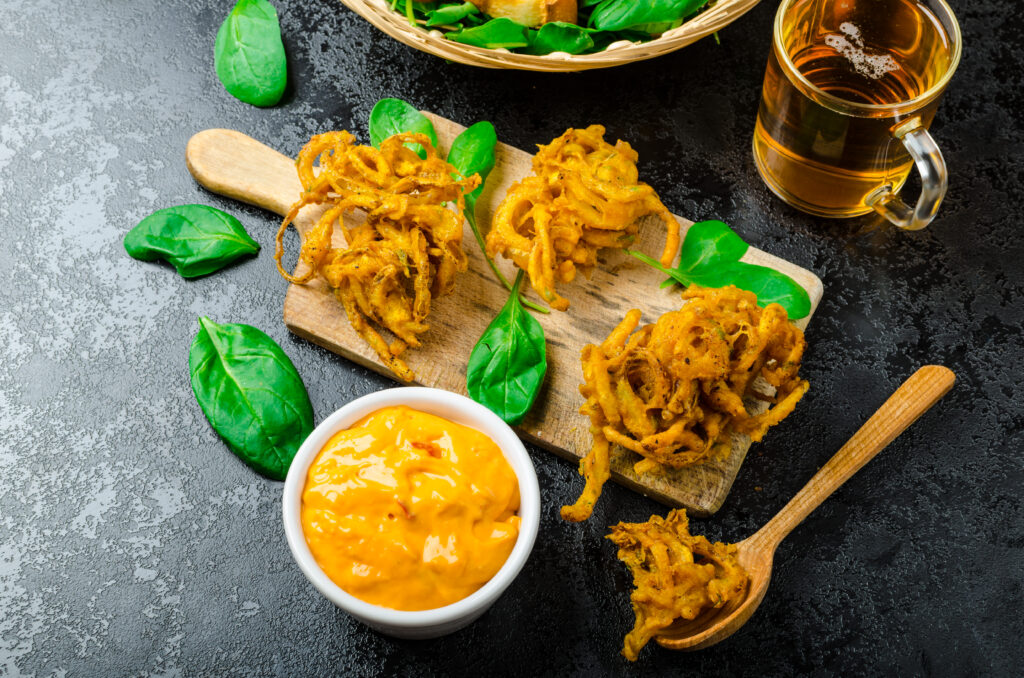
Ingredients:
2 large onions, thinly sliced
1 cup chickpea flour (besan)
1/2 teaspoon cumin seeds
1/2 teaspoon red chili powder (adjust to taste)
1/2 teaspoon turmeric powder
1 teaspoon garam masala
Salt to taste
A pinch of baking soda (optional)
Water, as needed
Vegetable oil for deep frying
Instructions:
- In a large mixing bowl, add the thinly sliced onions, chickpea flour (besan), cumin seeds, red chili powder, turmeric powder, garam masala, salt, and a pinch of baking soda (if using).
- Mix all the ingredients well, ensuring that the chickpea flour and spices coat the onions evenly.
- Gradually add water, a little at a time, and continue mixing until you achieve a thick batter that coats the back of a spoon. The consistency should be thick enough to coat the onions but not too runny.
- Heat vegetable oil in a deep frying pan or wok over medium-high heat. The oil should be hot but not smoking (around 350°F or 180°C).
- Carefully drop spoonfuls of the onion and chickpea flour mixture into the hot oil. You can use a spoon or your fingers for this.
- Fry the bhajis in batches, making sure not to overcrowd the pan. Fry them until they turn golden brown and crispy, which should take about 3-4 minutes per batch.
- Use a slotted spoon to remove the fried onion bhajis from the oil and drain them on a paper towel-lined plate to remove excess oil.
- Repeat the frying process for the remaining batter until all the bhajis are cooked.
- Serve the hot and crispy Onion Bhajis immediately with your favourite chutney, yogurt, or as a side dish with a main meal.
Murukku (Chakli)
Ingredients:
2 cups rice flour
1/2 cup urad dal flour (black gram flour)
1/4 cup butter or ghee (clarified butter)
1 teaspoon cumin seeds
1/2 teaspoon sesame seeds
1/2 teaspoon red chili powder (adjust to taste)
A pinch of asafoetida (hing)
Salt to taste
Water, as needed
Vegetable oil for deep frying
Equipment:
Murukku press or chakli maker
Star-shaped or round nozzle attachment for the murukku press
Instructions:
- In a mixing bowl, combine the rice flour and urad dal flour.
- Add cumin seeds, sesame seeds, red chili powder, asafoetida, and salt to the flour mixture. Mix well to combine all the dry ingredients.
- Melt the butter or ghee and pour it into the flour mixture. Mix it in to form a crumbly texture.
- Gradually add water, a little at a time, and knead the mixture into a smooth and stiff dough. The dough should not be too soft or too hard; it should be pliable enough to go through the murukku press.
- Heat vegetable oil in a deep frying pan or kadai over medium-high heat. To check if the oil is hot enough for frying, drop a small piece of dough into the oil; it should sizzle and rise to the surface.
- While the oil is heating, prepare the murukku press. Place a star-shaped or round nozzle attachment at the bottom of the press and fill it with a portion of the dough.
- Press the dough through the nozzle in a circular or spiral shape directly into the hot oil. You can make murukku in desired shapes and sizes.
- Fry the murukku until they turn golden brown and crispy, which usually takes about 3-4 minutes per batch. Make sure not to overcrowd the pan while frying.
- Use a slotted spoon to remove the fried murukku from the oil and drain them on a paper towel-lined plate to remove excess oil.
- Repeat the frying process for the remaining dough until all the murukku are cooked.
- Let the murukku cool completely before storing them in an airtight container. They will remain crispy for several days.
- Enjoy your homemade Murukku as a crunchy snack with tea or as a part of your festive treats.
Kaju Katli
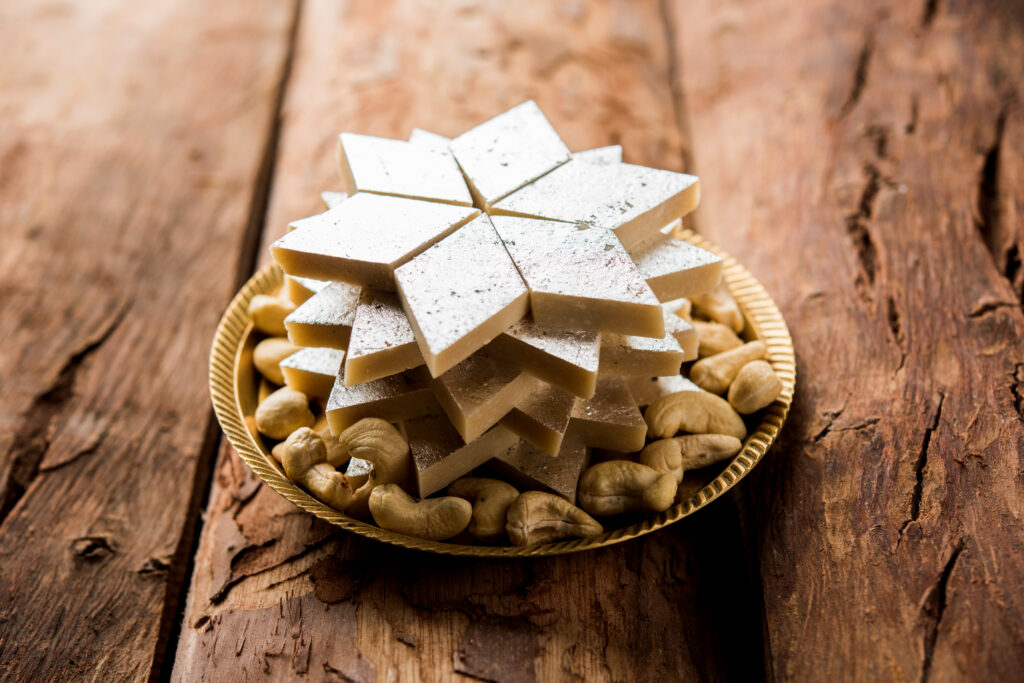
Ingredients:
1 cup cashews
1/2 cup sugar
1/4 cup water
1/2 teaspoon cardamom powder
A few drops of rose water (optional)
Ghee (clarified butter) for greasing
Instructions:
- Start by dry roasting the cashews. Heat a pan over low-medium heat and add the cashews. Roast them for a few minutes until they become lightly golden and aromatic. Be careful not to over-roast them.
- Allow the roasted cashews to cool down completely.
- Once the cashews have cooled, grind them into a fine powder using a food processor or a blender. Make sure to grind them to a smooth consistency without any lumps. This cashew powder is the key ingredient for Kaju Katli.
- In a separate pan, add the sugar and water. Heat over low-medium heat, stirring continuously until the sugar dissolves. You can add a few drops of rose water at this stage if you like for added flavour.
- Continue to cook the sugar syrup, stirring occasionally, until it reaches a one-string consistency. To test, take a small amount of syrup between your thumb and index finger; it should form a single string when stretched apart. This usually takes about 5-7 minutes.
- Once the sugar syrup reaches the one-string consistency, reduce the heat to low and add the ground cashew powder and cardamom powder to the syrup.
- Mix well to combine the cashew powder and syrup thoroughly. Continue to cook the mixture over low heat, stirring continuously, for about 4-5 minutes. It will start to thicken and leave the sides of the pan.
- Remove the mixture from the heat and transfer it to a greased plate or tray. You can use a little ghee to grease your hands and the plate to prevent sticking.
- While the mixture is still warm, flatten it into a smooth, even layer using a greased rolling pin or your hands. You can also place a piece of parchment paper on top to help spread and flatten it.
- Allow the Kaju Katli to cool completely, which may take about 1-2 hours.
- Once it has cooled and set, use a sharp knife to cut it into diamond or square shapes.
- Your Kaju Katli is ready to be enjoyed. Store it in an airtight container.
- Kaju Katli makes for a delightful sweet treat during festivals and special occasions. Enjoy!
Matar Kachori
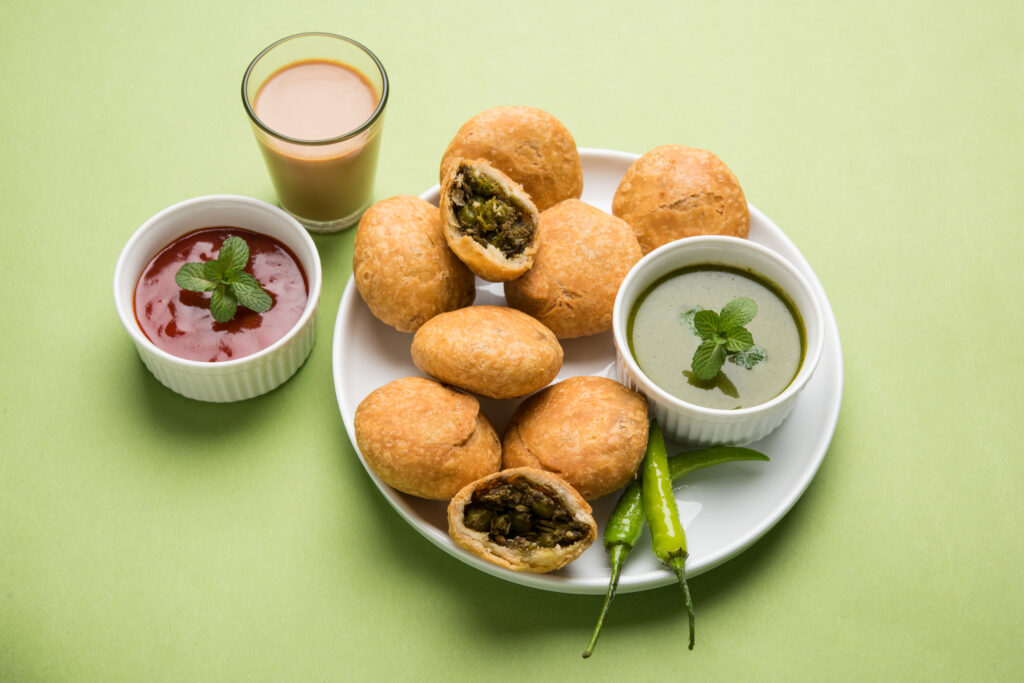
Ingredients:
For the Dough:
1 cup all-purpose flour (Maida)
2 tablespoons ghee (clarified butter)
A pinch of salt
Water, as needed
For the Filling:
1 cup green peas (fresh or frozen), coarsely ground
2 tablespoons oil
1 teaspoon cumin seeds
1/2 teaspoon asafoetida (hing)
1 teaspoon ginger-garlic paste
1/2 teaspoon red chili powder (adjust to taste)
1/2 teaspoon turmeric powder
1 teaspoon coriander powder
1/2 teaspoon garam masala
Salt to taste
A pinch of sugar (optional)
1 tablespoon chopped cilantro (coriander leaves)
Oil for deep frying
Instructions:
For the Dough:
- In a mixing bowl, combine the all-purpose flour, a pinch of salt, and 2 tablespoons of ghee. Mix well until the ghee is evenly distributed.
- Gradually add water, a little at a time, and knead the mixture into a stiff and smooth dough. Cover it with a damp cloth and let it rest for about 20-30 minutes.
- For the Filling:
- Heat 2 tablespoons of oil in a pan over medium heat. Add cumin seeds and asafoetida. Allow them to splutter.
- Add the ginger-garlic paste and sauté for a minute until the raw smell disappears.
- Add the coarsely ground green peas and cook for 5-7 minutes, stirring frequently, until they become fragrant and start to dry out.
- Add red chili powder, turmeric powder, coriander powder, garam masala, and salt. Mix well and cook for another 2-3 minutes until the spices are well incorporated.
- If you prefer a hint of sweetness, add a pinch of sugar (optional) and mix it in.
- Stir in the chopped cilantro and cook for a minute or two. Remove the filling from heat and let it cool.
To Assemble and Fry Matar Kachori:
- Divide the rested dough into small, equal-sized balls.
- Roll each ball into a small disc, about 3 inches in diameter.
- Place a spoonful of the cooled green pea filling in the centre of each disc.
- Gently fold the edges of the disc to cover the filling and form a stuffed ball.
- Press the stuffed ball slightly to flatten it, then roll it out into a 3-4 inch circle, taking care not to let the filling come out.
- Heat oil in a deep frying pan or kadai over medium heat.
- Carefully slide the prepared kachori into the hot oil, one at a time. Fry them until they turn golden brown and crispy, flipping them occasionally for even frying.
- Remove the fried matar kachori using a slotted spoon and drain them on a paper towel-lined plate to remove excess oil.
- Serve the hot and crispy matar kachori with chutney or as a snack.
- Enjoy your homemade Matar Kachori, a delightful and flavourful snack!
Potato Quinoa tikka patties with Imli Chole
Ingredients for Potato Quinoa Tikki Patties:
1 cup cooked quinoa
2 large potatoes, boiled and mashed
1/2 cup bread crumbs (use gluten-free breadcrumbs for a gluten-free version)
1/2 cup chopped mixed vegetables (carrots, peas, beans, etc.)
1 teaspoon cumin seeds
1/2 teaspoon red chili powder (adjust to taste)
1/2 teaspoon garam masala
Salt to taste
2 tablespoons oil for shallow frying
Ingredients for Imli Chole (Tamarind Chickpea Curry):
1 cup cooked chickpeas (canned or cooked from dried)
1 small onion, finely chopped
1 teaspoon ginger-garlic paste
1/2 cup tamarind pulp (soak tamarind in warm water and extract pulp)
1/2 teaspoon cumin seeds
1/2 teaspoon turmeric powder
1 teaspoon coriander powder
1/2 teaspoon red chili powder (adjust to taste)
1/2 teaspoon garam masala
Salt to taste
1 tablespoon oil
Fresh cilantro leaves for garnish
Instructions for Potato Quinoa Tikki Patties:
- In a mixing bowl, combine the cooked quinoa, mashed potatoes, bread crumbs, chopped mixed vegetables, cumin seeds, red chili powder, garam masala, and salt. Mix everything well to form a uniform mixture.
- Shape the mixture into small round patties or tikkis.
- Heat 2 tablespoons of oil in a non-stick skillet over medium heat. Place the tikkis in the skillet and cook until they turn golden brown and crispy on both sides, flipping them carefully. This should take about 3-4 minutes per side.
- Remove the tikkis from the skillet and place them on a paper towel-lined plate to remove excess oil.
Instructions for Imli Chole (Tamarind Chickpea Curry):
- Heat 1 tablespoon of oil in a pan over medium heat. Add cumin seeds and let them splutter.
- Add the chopped onions and sauté until they turn translucent.
- Stir in the ginger-garlic paste and sauté for another minute until the raw aroma disappears.
- Add turmeric powder, coriander powder, red chili powder, garam masala, and salt. Mix well.
- Pour in the tamarind pulp and cook for a few minutes until the mixture thickens slightly.
- Add the cooked chickpeas and a little water if needed. Simmer for 10-15 minutes, allowing the flavours to meld and the chickpeas to heat through.
- Garnish the Imli Chole with fresh cilantro leaves.
Vegan Palak Paneer (Palak Tofu)
Ingredients:
1 block of firm tofu, cubed
1 bunch of fresh spinach (or 10 ounces of frozen spinach)
1 large onion, finely chopped
2 tomatoes, chopped
2-3 cloves of garlic, minced
1-inch piece of ginger, minced
1 green chili pepper, chopped (adjust to taste)
1 teaspoon cumin seeds
1 teaspoon coriander powder
1/2 teaspoon turmeric powder
1/2 teaspoon red chili powder (adjust to taste)
1/2 teaspoon garam masala
2 tablespoons oil or ghee (clarified butter)
Salt to taste
Water, as needed
Cream or cashew cream (optional, for garnish)
Instructions:
- If using fresh spinach, rinse it thoroughly and blanch it in boiling water for about 2 minutes. Then, drain and immediately transfer it to a bowl of ice water to retain its vibrant green color. Once cooled, drain again and blend the spinach into a smooth puree. If using frozen spinach, thaw and blend it into a puree.
- Heat 2 tablespoons of oil or ghee in a pan over medium heat. Add the cumin seeds and let them splutter.
- Add the chopped onions and sauté until they become translucent.
- Stir in the minced garlic, ginger, and green chili pepper. Sauté for another 2-3 minutes until the raw aroma disappears.
- Add the chopped tomatoes and cook until they become soft and mushy.
- Add the coriander powder, turmeric powder, red chili powder, and salt. Mix well and cook for a few more minutes until the oil starts to separate from the tomato mixture.
- Add the cubed tofu and mix it with the tomato mixture. Cook for 3-4 minutes, allowing the tofu to absorb the flavours.
- Pour in the spinach puree and stir well. Add a little water to adjust the consistency of the gravy if needed.
- Simmer the mixture for 5-7 minutes, stirring occasionally, to allow the flavours to meld and the tofu to absorb the spinach sauce.
- Stir in the garam masala and cook for another 2 minutes.
- Taste and adjust the seasoning if necessary.
- Garnish the Palak Tofu with a drizzle of cream or cashew cream if desired.
- Serve hot with rice, naan, or roti.
- Enjoy your homemade Palak Tofu, a wholesome and nutritious Indian dish!
Conclusion
Diwali is a time for reflection, celebration, and renewal. Choosing to celebrate Diwali as a vegan is an act of compassion, not just for animals but also for your own health and the environment. It’s a way of embracing the festival’s message of light, love, and harmony in its truest sense. By making mindful choices about what we eat during Diwali, we can illuminate our lives with health, happiness, and the radiant spirit of compassion that Diwali represents. So, this Diwali, let your celebrations shine brighter by choosing veganism, and may your light of love and kindness illuminate the world.
1 Comments
Leave a Reply Cancel reply
You must be logged in to post a comment.


ritu jadon
ritujadon9088@gmail.com